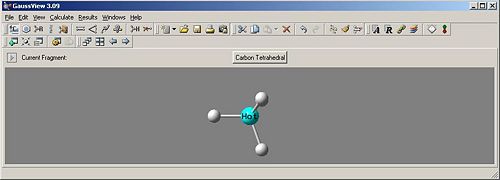Mod:gaussview
About Gaussian (16) and GaussView (6)
Gaussian is a set of programs for carrying out electronic structure calculations. Many different methods for carrying out total energy calculations of molecules are implemented, including molecular mechanics (or force field) methods, but mainly semi-empirical and ab initio molecular orbital-based methods. In addition, energy derivatives as a function of inter-nuclear coordinates can be calculated, making it possible to optimise and characterise minima and transition structures on molecular potential energy surfaces. A basic outline of the electronic structure theory needed to work with the program is now given as part of the QM3 course.
For more information, see:
P. W. Atkins, J. de Paula, R. Friedman: Quanta, Matter and Change (Oxford University Press 2009)
F. Jensen: Introduction to Computational Chemistry (Wiley, 2007)
D. A. McQuarrie: Quantum Chemistry (University Science Books, 2008)
C. J. Cramer: Essentials of Computational Chemistry (Wiley, 2006)
Learning to use GaussView
Before you can run calculations on the various molecules you will be looking at, you will need to know how to submit them as "jobs" to Gaussian. The easiest way to do so is to use GaussView to create the molecule and tell Gaussian what to calculate and how.
Direct link to online Manual
Go here for an up to date explanation of all the keywords. Gaussview is described [here].
Basics

Everything you need to make your molecular structure is available on the GaussView menu bar and it works primarily on a click and drag system. The first set of 11 icons from the left are what you need to create the desired structure.
They are:
Element Fragment - Brings up a periodic table for you to select an element and then it's structure and bonding.
Ring Fragment - This allows you to quickly create common compound rings.
R-Group Fragment - Gives easy access to common side chains.
Biological Fragment - Gives a selection of Amino Acids and Nucleosides to add to your molecule.
Custom Fragment - This allows you to save and load custom built structures.
Modify Bond - Clicking on two atoms to create bonds of varing types and set the distance between atoms.
Modify Angle - Clicking on three atoms allows you to specify the angle between them.
Modify Dihedral - Clicking on four atoms allows you to specify the dihedral angle between them.
Inquire - clicking two atoms shows you the distance between them, clicking three shows you the angle formed and clicking four shows you the dihedral angle formed.
Add Valence - Adds a Hydrogen bond to the selected atom.
Delete Atom - Deletes the selected atom.
Tutorial exercises are made available to you below. We suggest you work through these at your own pace. The GaussView tutorials assume you know where to find the relevant menus in GaussView. The Advanced tutorial should be taken after you have looked at the basic tutorial. If a section is proving very easy move onto the next one ...
The Help section is also very easy to follow. Click on the menu now to see what is available. As beginners the section on "GaussView Basics" and "Working with Molecules" are useful.
Work through as much as you need to - you may find you need to revisit the tutorials after attempting some of the exercises.
